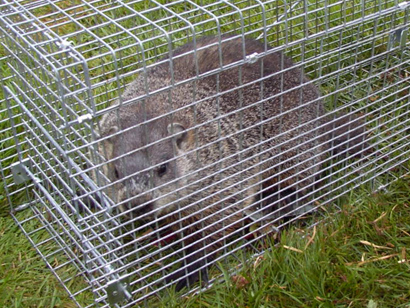- USA Wildlife Removal Education Guide and Resources
How To Get Rid of Groundhogs Yourself

Groundhogs are critters that can do an amazing amount of damage for their size. Since groundhogs live and tunnel underground, they can destroy the root system of your lawn and create huge holes that are unsightly and will attract your pets and other animals to dig in the holes and make them bigger. Groundhogs will also ravage your garden and eat all the vegetable roots that they come into contact with. One of the easiest ways to tell if you do have a groundhog infestation is that you will start noticing that your garden plants just start to die for no particular reason. Here are some do-it-yourself tips for getting rid of groundhogs if you have an infestation of them.
- 1) See if you can prevent them, by installing steel mesh on the ground digging areas, or fencing in your garden.
- 2) Use a large live cage trap to catch and remove them from the area.
- 3) Use a lethal trap, like a body grip trap mounted directly over one of the commonly used burrows.
- 4) If they are under a shed or porch, install a steel screen barrier around the perimeter of the structure.
If you are allowed to trap, you can buy or rent several different live and lethal traps from hardware and garden stores. Once you have the trap, wash it with soap and wear latex gloves while you set and bait it. If a groundhog catches your scent on the trap, they won’t go anywhere near it. Make sure that the trap is set on a flat surface by the entrance to the mounds and bait it with some nice fresh vegetables. Check the trap everyday and once you have caught them all, relocate them to a wooded area or a field at least 20 miles away from your home to ensure that they do not come back.
There are several repellents available to get rid of your groundhogs. However, many people say that the groundhog repellents do not work. There are several chemical sprays and predator scents that you spray around the perimeter of your yard, around your garden or in the mounds. These repellents are not very effective and they wear off quickly and have to be reapplied every few days.
If your groundhog population is not out of control yet, the best defense against them coming into your yard is to put a fence around your yard. If you do not want to put one around the entire perimeter of your yard, as this can be expensive, you can put it just around your garden. Make sure that the fence is made out of a sturdy wire mesh and is buried at least a foot underground to keep them from burrowing underneath the fence.
Go back to the main Groundhog Removal page for more information about how to get rid of groundhogs yourself.

Groundhogs, also called woodchucks, are ground squirrels that make their homes under your lawn. While groundhogs are cousins of the bushy tailed gray squirrel, you will rarely see groundhogs above the surface of their subterranean tunnels. However, groundhogs are not only restricted to their dark tunnels, but they can also climb and swim which gives them the ability to live in practically any climate and environment. In fact, you may not even realize that you have a groundhog problem at all until you see the mounds of dirt in your garden and lawn that are created from them digging their burrows. Groundhogs are mainly solitary creatures that rarely harm anyone, but if you are a gardener, you may feel differently.

